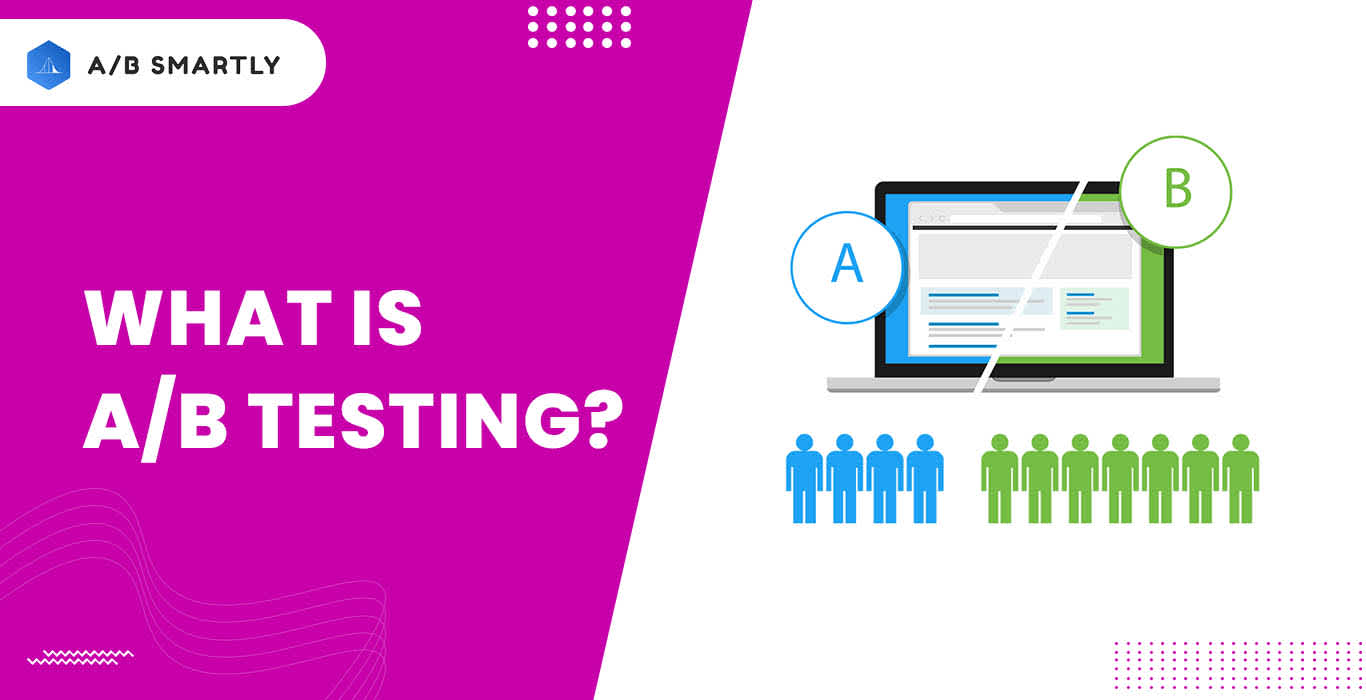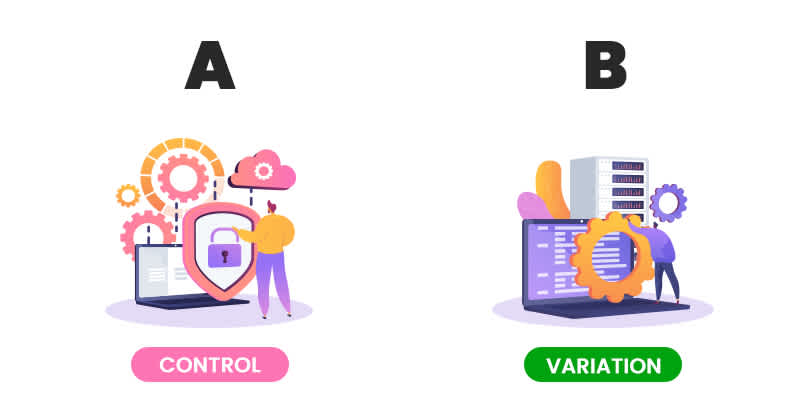
What is A/B Testing? A Beginner’s Guide
By Simran Arora on Jun 27 2022 | Be the first to comment
Introduction
A/B testing is also termed bucket testing or split testing. It is simply a way to compare different versions of an app, or a webpage, or a feature, with each other to analyze which one gives the best performance.
In A/B testing, the users are shown two or more versions of a web page, screen, or feature. After that, statistical analysis is applied to understand which version does better according to the targeted conversion rate or another metric best suited for the change in hand. This further helps to determine which version drives business metrics and leaves a positive impact on the users.

In A/B testing, A means ‘control’, or original testing variable. On the other hand, B means ‘variation’, or the novice version of the original variable.
Furthermore, A/B tests can potentially escalate the efficiency of the marketing, product, customer success, sales or even infrastructure efforts of an organization.
To understand the concept in detail, let us dive into this article. But, before we commence, let’s see the overview of what we shall cover:
What is A/B testing?
How does A/B testing work?
Benefits of A/B testing
What to test in A/B testing?
A/B testing and SEO
A/B testing: Full-stack or client-side
Do’s and don’ts of A/B testing
Conclusion
Let’s begin!
What is A/B testing?
A/B testing is a method by which you can accumulate quantitative user insights. This data is used by various organizations to analyze user behavior, weak points, engagement rate, etc., but especially to understand which experience makes the biggest impact in specific metrics.
Understanding the details about your website or any other asset can help you make informed decisions for your organization.
A/B testing helps you make efficient decisions based on data; it’s the best tool to understand the impact your changes cause on business metrics.
If you are not running A/B tests, then you are lagging or will be, and eventually will be surpassed by your competition.
Now, let us understand the working of A/B testing in detail.
How Does A/B Testing Work?
If you plan to run A/B tests in your organization, it is important to understand when they can be used.
You must carry out a comparison between the current version of a page or element with one or more variations of it that you wish to test. For example, you can perform the test on a website page, some features in that page, an element, an image, changes related to the customer behavior, sending a new email to customers or sending it at a different time of the day, or even algorithms or infrastructure changes, and much more. But it’s a lot more difficult to run A/B tests when the two variants can’t be done simultaneously, like when you want to test the impact on SEO or offline advertising. For those, there are other experimentation or causal inference methods, without random assignment, called quasi-experiments.
Working
There are three parts that need to be tackled: run an A/B test, variant generation based on random assignment, an event pipeline to collect all the metrics, and finally, dashboards with statistics for decision making.

There are many open-source or third-party products that help you with all or some of those tasks. You could even use GA to track your metrics, although using Google Analytics for your A/B testing reports is not recommended. See this great post from Georgi Georgiev about the subject.
Even though there are so many A/B testing platforms out there, we see that more and more of the businesses that start growing their A/B testing efforts outside of the Marketing department, or that aim to optimize more than a few landing pages or UI features, end up considering building their platform internally.
A/B testing makes it easy to understand the impact that new features or changes have on the business. On the other hand, it is not trivial to understand what’s causing that impact or the change in user behavior. If you see results that you don’t expect it’s necessary to spend some time to understand what’s happening behind the scenes. For this reason it’s ultra helpful to track as many metrics as you can that will allow you to understand the user behavior. Look at bounce rates, click-through rates from page to page, usage of different features through the main funnel, etc. Furthermore, you can also collect more qualitative user insights. Look at heat maps or individual visitor session recordings of a sample of users in the different variants to provide additional insights regarding the customer’s actions and behavior.
Both the versions are exposed to the visitors. Afterward, a statistical engine analyses the data collected in the dashboard that showcases the users’ engagement with both versions.
As you can observe, this testing gives you a transparent insight into the progress of your website or app.
Here are some vital points that you must remember while performing A/B testing:
Set your goals: it is essential to know what you wish to accomplish through the A/B test. You must focus on one metric initially. Gradually you can perform the tests on other metrics, and this helps you to get clear data.
Select the element to test: you shall go step-by-step. Choose one element at first and make sure it is associated with the metric you wish to improve.
Perform complete analysis of the existing data: you must analyze the existing data first by using some reliable and credible tools such as Google analytics. The data accumulated becomes your foundation and the deciding factor of further improvement.
Build a variant: when you take the A/B test, make sure that you build a variant. This variant is the modified version of your existing element or a webpage. For instance, if you are changing the homepage, modify the font style or images in your variant and keep the rest of the elements as it is
Perform the A/B testing: select the elements that, according to you, would improvise the target metric.
Select the best A/B testing tools: perform proper research based on the best available A/B testing tools. This step is important as the tool is responsible for providing you with accurate data.
Benefits of A/B Testing
A/B testing is an incredible method to check the hypothesis by testing your idea directly on the targeted audience. It helps you to validate the modifications made to the website.
There are a plethora of advantages of A/B testing. Here is a list:
Escalate conversion rate: to enhance the general conversion rate, A/B testing assist you to optimize your website and improvise the user’s experience
Manage your budget and time: running an organization is not a smooth walk, and it requires a lot of dedication and management. A/B testing helps you to invest your time in the budget in a way that results in productivity and positive growth.
Analyzing the user’s behavior: The testing allows you to analyze the impact of each element of the website on your visitors. This further helps you focus on the user’s requirements that would, in turn, benefit you.
Enhancing the engagement of visitors: A/B testing helps you to understand what the audience needs. Make the modifications as per the user requirements.
Make informed decisions according to the quantified results: assess the results after completion of the testing process. Jot down the analytics and prepare a plan accordingly.
A/B Testing and SEO
A/B testing is an incredible opportunity for organizations to make appropriate changes and hike their conversion rates.
Google very much supports and recommends the usage of A/B testing.
What to Test in A/B Testing?
A common question remains, _what to test in A/B testing? _We have curated a list of a few vital elements where you can start the testing:
Titles and headers: making small changes can create a big difference. You can change the content of the blogs or the font size, font style, and color to make them more presentable and attract users.
Forms: All the forms on your website must be clear and user-friendly. You can add or modify the titles, text boxes, and even format lines or columns to make it easy for the visitors.
Call to action: Call to action buttons are extremely important for your website. Make the title catchy such as buy, purchase now, order, etc., to enhance your conversion rate.
Images: Images play an important part in the overall design of your website. Consider experimenting with the aesthetic and size of the photos.
Navigation: with navigation, you can allow your users to access multiple conversion tunnels through the navigation
Landing pages: landing pages let the users take certain actions. A/B testing helps you to perform a comparison between different versions of such features with several designs or layouts.
Page structure: The page structure of the website has to be clean and well crafted. You can add images, a carousel, new products to your home page.
Business models: analyze your business model in and out to generate additional profits
Algorithms: you can experiment with different algorithms to convert your visitors into customers
Why A/B Testing?
There are instances where the B2B businesses are not satisfied with their leads or worry about the lower user engagement.
Sach vital conversion metrics have a huge impact by several obstacles in the conversion funnel path or drop-offs on the payment page, etc. This is where A/B testing comes into the picture.
Here are some important points to know about the reasons to opt A/B testing:
Achieve ROI from the current traffic.
Minimize the bounce rate.
Resolve users’ concerns.
Make statistical improvements.
Make frequent design changes to the website.
Achieve ROI from the current traffic
A/B testing helps to escalate conversions without making further investments to gain new traffic. As you understand, it is a costly affair to acquire new and quality traffic for your website. A/B testing provides you with a higher ROI as some significant changes in the website can increase the conversion rates.
Minimize the bounce rate
Analyzing the bounce rate is a vital factor to understand the performance of your website. Although, there is no one solution to manage the bounce rate for a website. Every website has its objectives and a different set of audiences. Therefore, it is mandatory to analyze the requirements of your visitors and make improvements accordingly. This makes the user spend more time on your website and leads to convert them into customers.
Resolve the user’s concerns
Any visitor lands on the website to accomplish a particular goal. It can be to buy a product, service, or understand a particular topic. However, there can be a few obstacles in the user's way, such as difficulty finding the CTA button, complex forms, or user interface.
This may result in a bad user experience, and the user may never visit your website again. Therefore, you must analyze the data by studying the visitor’s behavior and make significant changes to your site.
Make statistical improvements
A/B testing is all about the data collected regarding the user’s behavior on various metrics. There are various factors such as click-through rate, bounce rate, times spent on a particular webpage, number of forms filled, etc. you must work diligently to excel these matrices to increase the conversion rate for your website.
Make frequent design changes to your website.
It is recommended to make minute design changes every now and then, and it gives a sense of freshness to the users whenever they land on your website. The modification can be as minor as changing the color of the header or changing the font style.
You can compare the older and the new version with the help of A/B testing and analyze which one performs better.
A/B Testing: Full-stack or Client-Side
It can be ambiguous to choose the approach for A/B testing. However, the best approach depends on various factors such as the company's structure, the development life-cycle, resources, and the complexity of experiments.
Client-side approach
Several factors make the client-side approach quite flexible in terms of marketing.
You can quickly deploy or create front-end tests.
It is possible to modify web pages in the user’s browsers directly.
Server-side approach
Whenever some significant changes occur on the back-end architecture side, the changes reflect as soon as the HTML pages load.
It is possible to take in-depth tests and personalizations to improve the architecture of the website.
You can control several metrics of the tests from the coding environment directly.
In a nutshell, the client-side approach is a great pick for digital marketers, as there is no requirement for advanced technical skills. The teams can expect faster test results as well as a short period of experimenting.
On the other hand, server-side testing consists of core technical and complicated resources. The experimentation is remarkably powerful and scalable.
Do‘s and Don’ts of A/B Testing
We have curated a list of some practices that you must opt for and refrain. Take a look.
Do’s of A/B testing
Analyze the structure of your website diligently.
Understand the user’s behavior and their demands from your website.
Filter the important elements to perform A/B testing.
Keep your goals clear.
To enhance the optimization process, try to combine client-side and full-stack together.
Don’ts of A/B testing
Opting for complicated tests in the beginning.
Not prioritizing the launch of the tests.
Testing without a prior plan.
Not considering the insights and implementing them into your websites for further improvement.
Ignoring minute behavioral changes of your visitors.
Conclusion
This article gives you an elaborated insight into the A/B testing. We hope that you can comfortably form a layout for your improvisation journey.
The analytics may not favor you if the focus is not put on the minute details sincerely. This method is top-notch when it comes to escalating the conversion rates for your website.
We advise you to gain complete knowledge before taking the A/B test as there are plenty of key points to take care of!
It will assist you in improvising the design of your website by removing the weak links and reaching up to the most optimized version of your website.
Good luck!
Frequently asked questions on A/B testing
What is the definition of A/B testing?
A/B testing is the process of comparing two variations of a page element, usually by testing users’ response to variant A vs. variant B and concluding which of the two variants is more effective.
Related Posts

0 Comments
Copyright 2020 - A/B Smartly | Terms and Conditions | Privacy Policy | Security | GDPR & HIPAA | Blog




